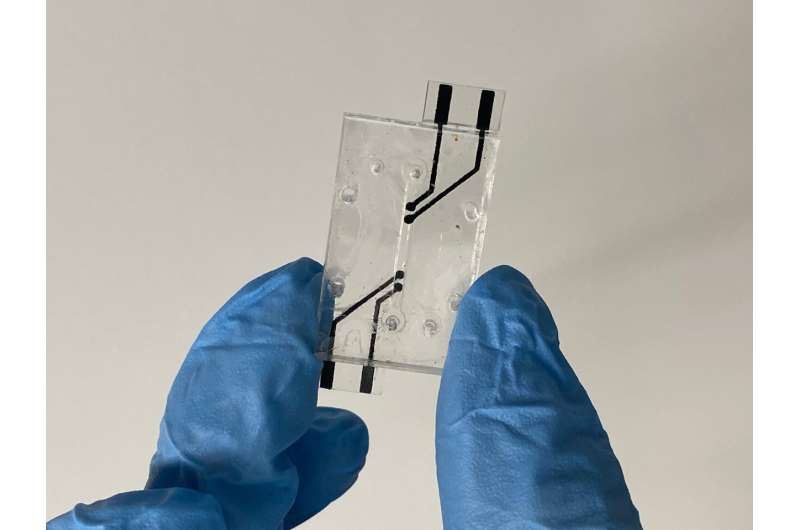This article has been reviewed according to Science X's editorial process and policies. Editors have highlighted the following attributes while ensuring the content's credibility:
fact-checked
proofread
Scientists incorporate electrodes with beneficial features into customizable organ-on-a chip device

The Terasaki Institute for Biomedical Innovation (TIBI) has developed a novel organ-on-a-chip device for measuring electrical resistance across endothelial barriers. This chip had carbon-based, screen-printed electrodes incorporated into a multi-layered, microfluidic chip fabricated by a simple and cost-effective method.
Endothelial cells line blood and lymph vessels of the body and form a barrier layer which controls the flow of fluid and substances to and from the vessels and surrounding tissues. Study of the crucial roles that endothelial barriers play in healthy and disease states—most notably with the blood brain barrier—have prompted the need for in vitro models for research and therapeutic drug development.
Typical sensors for these types of studies measure trans-endothelial electrical resistance (TEER), a primary indicator of the strength and integrity of an endothelial barrier. Incorporating a TEER sensor into an organ-on-a-chip allows one to measure TEER in real-time in an in vitro model that recapitulates an endothelial barrier in the body.
There is, however, a lack of standardization in these models. TEER measurements are notoriously difficult to obtain with accuracy, and they can be subject to variations in temperature and device design, as well as electrode shape and position.
There are inherent drawbacks in electrode fabrication as well. One method commonly used is to insert platinum wires into the chip. This manual assembly results in limited throughput and consistency. An alternative method using physical vapor deposition of metallic materials onto a substrate circumvents these problems but necessitates microfabrication facilities and special training. In addition to fabrication, electrode material costs and availability should be considered, as these can vary widely.
Taking these factors into account, the TIBI team elected to screen print electrodes on to the chip, using commercially available, inexpensive printing components. These components, of the sort used for T-shirt silk screening, included a screen-printing frame, carbon ink, and a squeegee. In place of silkscreen mesh stencils, more economical thin paper stencils were prepared. After printing, the imprint was heat cured, resulting in a firmly adhered carbon-based electrode that was both electrically conductive and biocompatible.
In designing their device, the team chose a less commonly used plastic called poly(methyl methacrylate) (PMMA), both for its properties conducive to rapid and scalable fabrication methods and for its hydrophilic nature, which avoids unwanted adsorption of certain hydrophobic molecules onto its surface.
The chip included a porous membrane for growing cellular barriers, sandwiched between two PMMA layers, which are in turn sandwiched between two screen-printed electrode containing PMMA layers. The team utilized a hybrid method for bonding the PMMA layers, which had a strong seal and prevented leakage while avoiding deformation and clogging of the chip's microfluidic layers.
To test the chip, layers of brain endothelial cells were cultured onto the porous membrane, and the TEER values for the in vitro barrier were measured experimentally for four days. These data were compared against other TEER values for this type of endothelial barrier, and there was good correlation, with the measured TEER values increasing as more cells grew and strengthened the barrier.
Furthermore, the introduction of a barrier-disrupting inflammatory protein resulted in a decrease in TEER values, further validating the measurements obtained with the new chip.
This proof-of-concept work by the TIBI scientists could lend itself well to automation and standardization, with the potential for adapting the chip to a plate format and the utilization of ink-jet printing for electrode fabrication, for example. And while additional application-specific optimization may be necessary, it has the versatility to be used with various cell types and geometric designs for different uses.
"We've taken an important step by surmounting the challenges involved in creating TEER sensors for organ-on-a-chip devices," said TIBI Director and CEO, Ali Khademhosseini, Ph.D. "This could lead to a greater technological expansion for a variety of research applications and therapeutic drug development."
The study is published in the journal Biomedical Microdevices.
More information: Satoru Kawakita et al, Rapid integration of screen-printed electrodes into thermoplastic organ-on-a-chip devices for real-time monitoring of trans-endothelial electrical resistance, Biomedical Microdevices (2023). DOI: 10.1007/s10544-023-00669-9


















